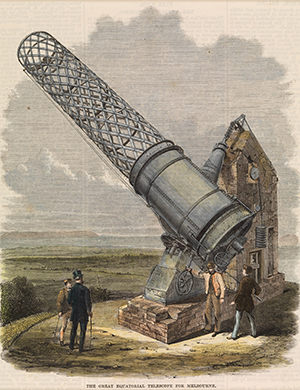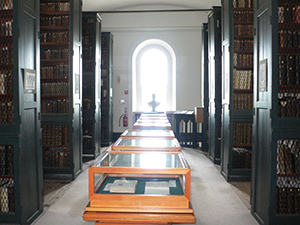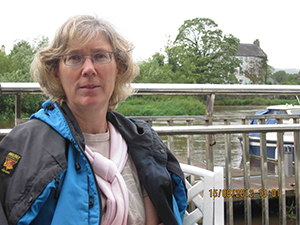BITE-SIZED HISTORY
Published in Issue 3 (May/June 2016), News, Volume 24BY TONY CANAVAN

The Great Melbourne Telescope.
 A forgotten collection of memorabilia was recently unearthed in Derry. Among the items in Frankie McMenamin’s collection is a Dublin Castle arrest warrant for Kevin O’Higgins, the architect of the Irish Free State; a cheque for £11 19s. signed by Terence MacSwiney, the lord mayor of Cork who died on hunger strike in Brixton Prison in 1920; and an armband from the second battalion of the Ulster Volunteer Force based in Raphoe, Co. Donegal. In particular, Mr McMenamin is eager to find out more about one Patrick O’Brien, whose medal, awarded for participation in the 1916 Rising, is now in his possession.
A forgotten collection of memorabilia was recently unearthed in Derry. Among the items in Frankie McMenamin’s collection is a Dublin Castle arrest warrant for Kevin O’Higgins, the architect of the Irish Free State; a cheque for £11 19s. signed by Terence MacSwiney, the lord mayor of Cork who died on hunger strike in Brixton Prison in 1920; and an armband from the second battalion of the Ulster Volunteer Force based in Raphoe, Co. Donegal. In particular, Mr McMenamin is eager to find out more about one Patrick O’Brien, whose medal, awarded for participation in the 1916 Rising, is now in his possession.
Britain’s Institution of Engineering and Technology is currently working on a multi-year project to conserve its Silvanus P. Thompson collection of pamphlets. One pamphlet (from 1869) concerns the Great Melbourne Telescope, which was at that time the world’s largest steerable telescope. It was in fact built in Dublin by Thomas Grubb, then considered one of the world’s leading telescope-makers. The Great Melbourne Telescope was later moved to an observatory near Canberra, where it was all but destroyed in a bush fire. The remains ended up in the Victoria and Albert Museum, London. There is a major project under way to restore this Irish-made telescope to its former glory in its original home in Melbourne.
Steps are being taken to save the rare and valuable collection of 12,000 books and manuscripts in Cashel’s Bolton Library. The collection includes at least 50 items not recorded anywhere else in the world and about 800 that no other Irish collection contains. It is named after the seventeenth-century archbishop of Cashel Theophilus Bolton, who began to amass medieval and early modern manuscripts and books, including the Nuremberg Chronicle (1493), Quattro Libri dell’Architettura (Venice, 1616) by Andrea Palladio, a highly influential study of classical architecture, and 24 works by Robert Boyle of Lismore (1627–91), the pioneering seventeenth-century scientist, as well as a rare proclamation from the Confederate Catholics of Ireland, printed in Kilkenny in 1648. In 1835 the Bolton collection was moved from the archbishop’s palace to a purpose-built chapter house on the grounds of the Church of Ireland cathedral in Cashel. The environment was unsuitable and unfortunately many of the books have deteriorated. In 1995 Dean Philip Knowles initiated a fledgling partnership with the University of Limerick (UL), which has resulted in an agreement between the Church of Ireland and UL to care for, preserve and manage the Bolton Library collection and create a permanent exhibition in Cashel. UL will restore as much of the material as possible and provide a humidity- and temperature-controlled environment for it. For the time being the collection will be housed in the Glucksman Library at UL.
(See ‘Gems of Architecture’, HI 16.5, Sept./Oct. 2008, https://www.historyireland.com/18th-19th-century-history/the-bolton-library/.)
An appeal has been launched to properly honour the grave of Henry O’Neill (1798–1880), who did more than anyone else to champion the Celtic cross in the Irish landscape. Although ranking with such luminaries as du Noyer, Wakeman and Petrie, who did pioneering work on Irish antiquities, O’Neill was largely forgotten until the recent publication of Dr Peter Harbison’s Henry O’Neill of the Celtic cross (Wordwell). O’Neill is buried in an unmarked grave in Glasnevin cemetery, and now author Elizabeth Healy is fund-raising to have his grave marked in the most appropriate way—with a Celtic cross. More information about supporting this fund is available from elizhealy@eircom.net; donations may be made to Healy/O’Neill fund AIB Blackrock a/c no. 11227199, sort code 93 36 78.

Recently the Industrial Heritage Association of Ireland (IHAI) announced their tenth annual Industrial Heritage Awards for 2015. The ceremony was held in the ESB Head Office, Lower Fitzwilliam Street, Dublin 2. The winners were: Best Industrial Museum—Titanic Belfast; Special Achievement Award—Paul Duffy, for his work on the archaeology and history of Galway; Lifetime Achievement Award—W.A. McCutcheon, the pioneering historian of industry in Ulster; Mary Mulvihill Media Award—Padraig Yeates, author and former columnist with the Irish Times. This was the first year that the IHAI instituted a new award category in honour of the late Mary Mulvihill, who contributed so much to the promotion of Ireland’s scientific, technical and industrial heritage.
Those following British politics will know that the House of Lords has been a thorn in Prime Minister David Cameron’s side. Now they have thwarted another attempt to modernise parliament. In February 2016 it was proposed that all new laws be recorded on paper instead of vellum. Remarkably, this practice of a scribe writing out the statutes by hand on vellum, which dates back to the Domesday Book, is still used to record laws passed in a 21st-century parliament. Despite assurances that good-quality archive paper would be used to replace vellum, the Lords were having none of it. Some peers with a legal background dug up a nineteenth-century ruling that gave the upper house the last say on how laws should be officially recorded, and the Lords duly said ‘no’ to archive paper.
















